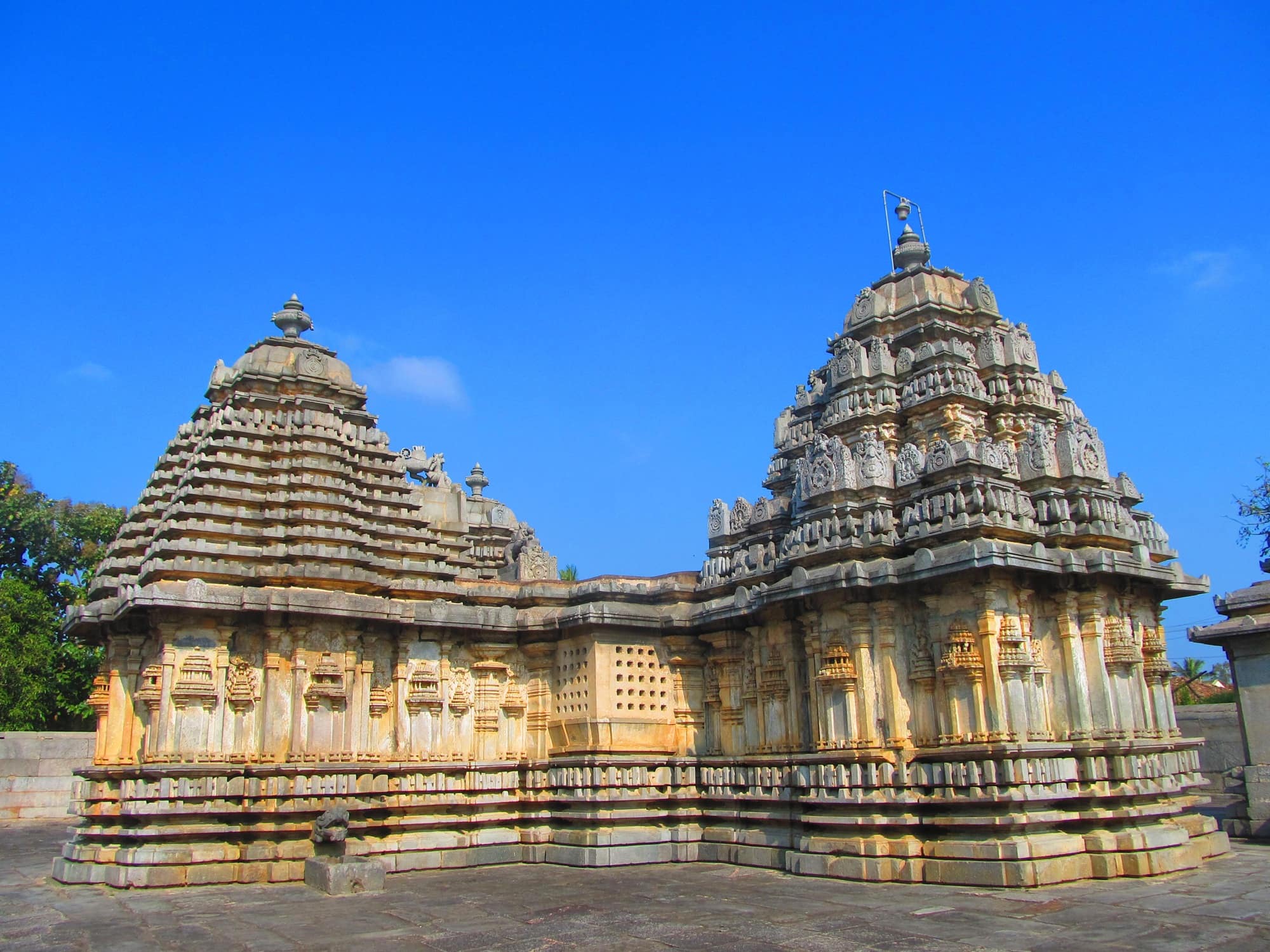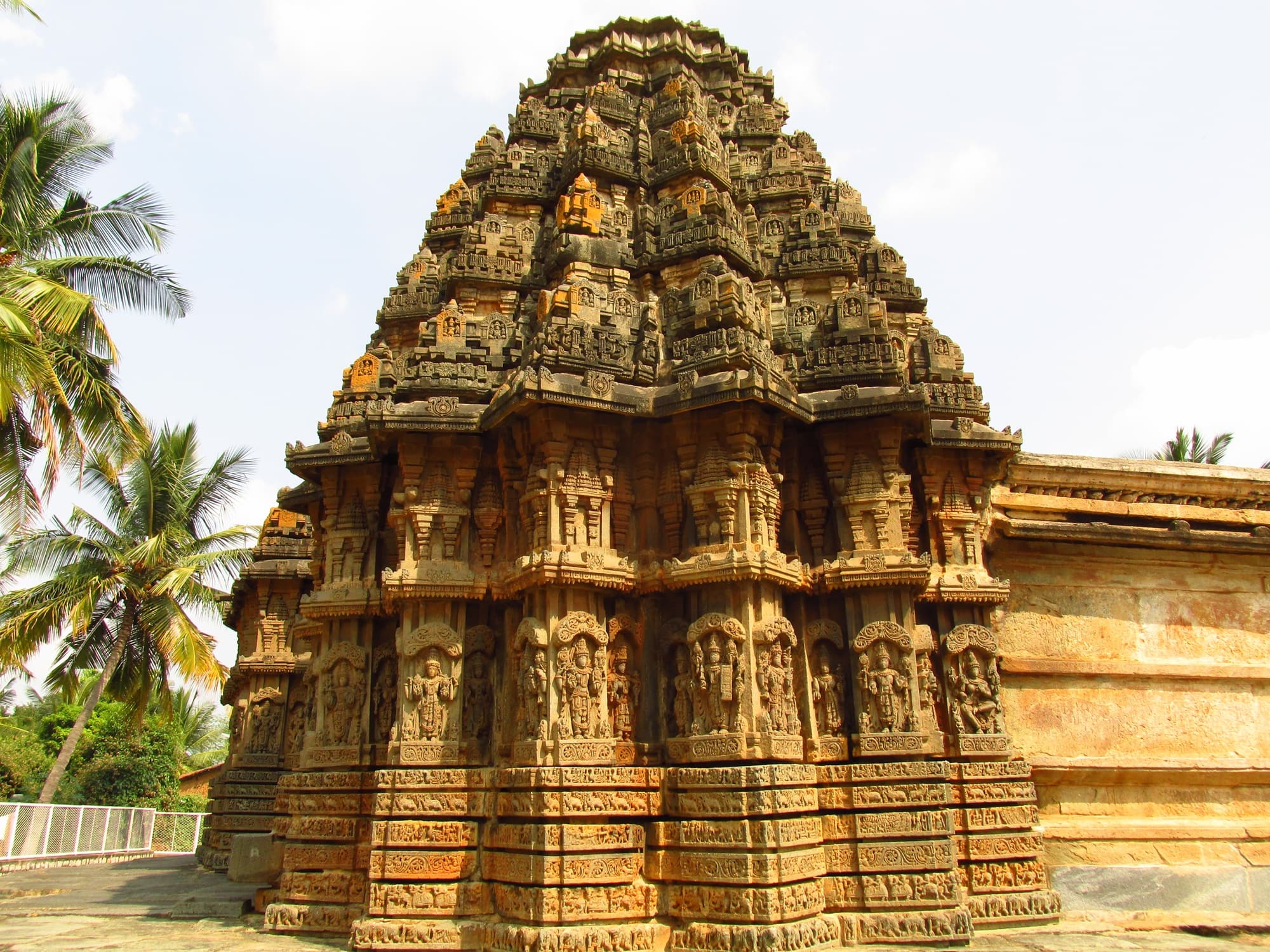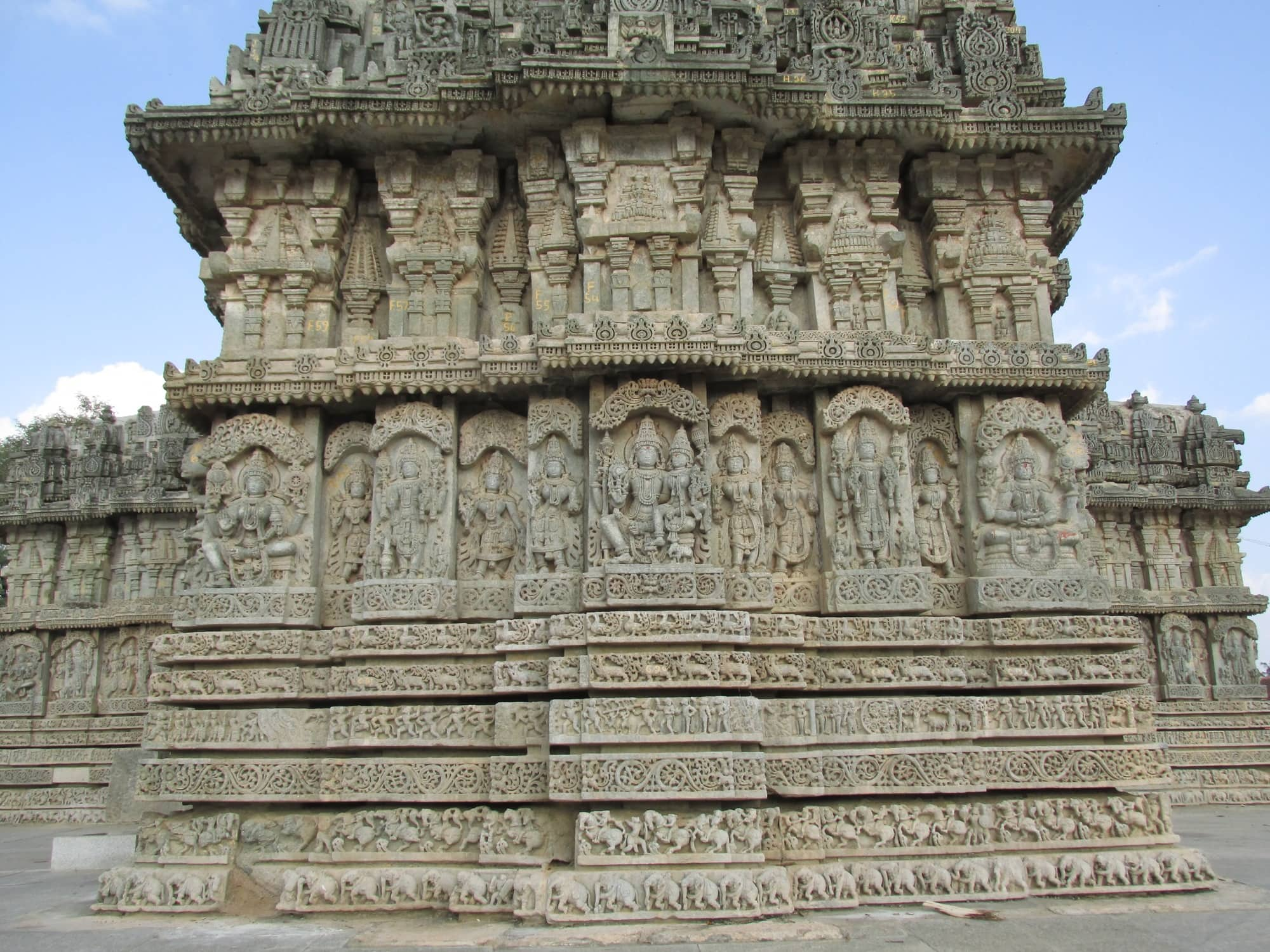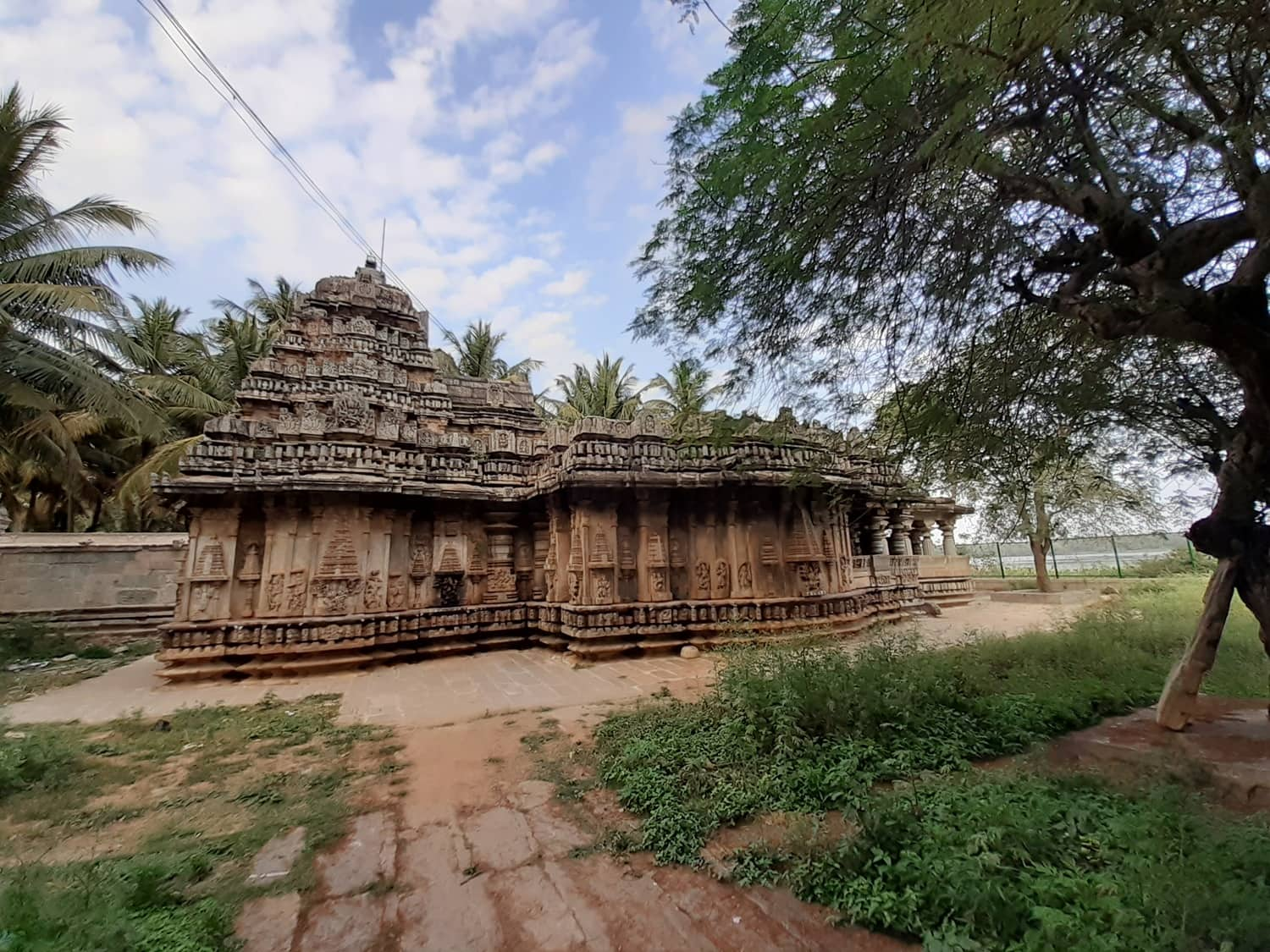



Centuries ago, when a Jain guru called Sudatta Muni sat in prayer in a forest, he was attacked by a lion. Sala, a young man who happened to be nearby, came to his defence and killed the lion. The story holds that when the lion attacked, Sudatta said ‘Hoy, Sala’ – ‘hoy’ meaning ‘strike’. Local lore crystallised into legend, and Sala came to be regarded as the founder of the Hoysala dynasty, which ruled over most of what is now southern and central Karnataka, extending into neighbouring states.
 Vivid depiction of Sala striking the lion from a temple complex at Mosale. (Source: Arjun Kumar)
Vivid depiction of Sala striking the lion from a temple complex at Mosale. (Source: Arjun Kumar)
The creation of this legend, or at least its amplification, is attributed to a Hoysala ruler called Vishnuvardhana. In a land vied for by both the Cholas and the Chalukyas, the Hoysalas were initially feudatories of the latter. In the early 12th century, with the other dynasties on the decline, Vishnuvardhana grabbed the opportunity and established an independent kingdom. The legend of Sala lent legitimacy to his throne.
Vishnuvardhana commemorated his achievements by building magnificent shrines at Halebid and Belur, arguably the finest examples of stone sculpture in all of India. In 2023, the magnificent Hoysala temples of Somnathpur, Halebid, and Belur achieved UNESCO World Heritage status. However, the magic of the Hoysala artisans was not limited to merely three places but found expression in almost every village that lay within their empire. Here are a few examples:
Doddagaddavalli (Hassan district): Built in a picturesque setting near a waterbody, the Lakshmidevi Temple is unique as it comprises four sanctum sanctorums built around a central mandapa, making it a ‘chatushkuta’ temple. This is a feature that none of the three better-known Hoysala sites have. The sanctums are topped by towers, with the eastern one being the most prominent. This is the main shrine, dedicated to Lakshmi. Apart from the four shrines, there is also a fifth of similar size within the complex, dedicated to Bhairava.
 The Lakshmi Devi temple at Doddagaddavalli. (Source: Arjun Kumar)
The Lakshmi Devi temple at Doddagaddavalli. (Source: Arjun Kumar)
Dating to 1113, the temple’s patron builder was a wealthy merchant, together with his wife. Though it did not have a royal builder, it conforms to the Hoysala pattern of using chlorite schist, popularly called soapstone, as the main building material. Despite this, sculpting is not elaborate here, indicating it was one of the early shrines.
Atop the temple, the symbol of the Hoysala rulers is visible – a crouching Sala striking the lion. Inside, acting as dwarpalas of the main sanctum, are two giant demonic figures. But the temple is not intact. In a truly shocking incident, the Mahakali idol inside one of the sanctums was found desecrated and damaged in 2020, underlining how vulnerable the site is.
Govindanahalli (Mandya district): If Doddagaddavalli’s chatushukta shrine was unusual, the Panchalingeshwara Temple here, with five sanctums, is even rarer. In this case, there are five shrines built with a common pillared hall on their eastern side. Inside each shrine is a Shiva linga. The second and third shrines here have a doorway in front.
 The Panchalingeshwara Temple at Govindanahalli - five sanctums clearly visible. (Source: Arjun Kumar)
The Panchalingeshwara Temple at Govindanahalli - five sanctums clearly visible. (Source: Arjun Kumar)
Dated to 1238, it was built during the reign of the Hoysala king Someshwara. Its architecture shows an evolution over the Doddagaddavalli temple. The outer part of the temple is embellished with various divine figures, each intricately carved. Rising above each sanctum is a pyramid-like tower. And thankfully, it remains truly protected.
Aralaguppe (Tumkur district): Also built under the patronage of Someshwara and dated to 1250 CE, is the Chennakesava Temple here. The two striking features that instantly distinguish it from the two earlier shrines are the platform – called jagati – that it stands on, and the wealth of carving on its outer walls. Row upon row of marching figures on its walls – depicting humans, animals, and divine beings – remind a visitor of the more illustrious Hoysala World Heritage temples but underline how visually attractive even the lesser-known ones are. The marching figures bring alive stories from Hindu epics, each row having its own symbolism. The jagati is in the shape of a sixteen-pointed star, with each point ending in an elephant, giving it the appearance of a chariot.
 The Chennakesava temple at Aralaguppe. (Source: Arjun Kumar)
The Chennakesava temple at Aralaguppe. (Source: Arjun Kumar)
The temple here at Aralaguppe is one of hundreds such in the districts of Tumkur, Mandya, and Hassan. To those who know, the names of Koravangala, Javagallu, Mosale (all Hassan district), Hosaholalu and Kikkeri (Mandya district), and Nagalapura (Tumkur district) are not ordinary villages but awe-inspiring Hoysala temple sites – and those are but a few of a long list of names.
 A strikingly carved outer wall of the Narasimha Temple at Javagallu. (Source: Arjun Kumar)
A strikingly carved outer wall of the Narasimha Temple at Javagallu. (Source: Arjun Kumar)
It is a great pity that most of the temples are not better protected and preserved. Or that public interest is limited to the big three. The need for protection is underlined by recent events at Kikkeri’s Brahmeshwara Temple. Located fourteen kilometres from the Jain pilgrimage site of Shravanabelagola, the Brahmeshwara dates to 1171 CE, which puts it in the reign of Hoysala ruler Narasimha I. Its outer walls are embellished with carvings. However, in 2014, several sculpted icons were stolen, and the case remains unsolved. Also in Kikkeri is the neglected Janardhana Temple, whose idol is now in the Metropolitan Museum of Art, New York.
 The Brahmeshwara Temple at Kikkeri. (Source: Arjun Kumar)
The Brahmeshwara Temple at Kikkeri. (Source: Arjun Kumar)
The temple is no longer in worship and has been used as a store. Did the theft of the idol cause the temple to be neglected?
According to Shashidhara HG, a heritage enthusiast and expert who has explored nearly a thousand Hoysala temples in the state, “It is worth saving one ancient temple than constructing a new temple spending thousands of crores.” To preserve the magical wonderland of Hoysala temples, the authorities need to widen their lens and look at the larger landscape, beyond what has already won recognition.
Discover the latest Business News, Sensex, and Nifty updates. Obtain Personal Finance insights, tax queries, and expert opinions on Moneycontrol or download the Moneycontrol App to stay updated!
Find the best of Al News in one place, specially curated for you every weekend.
Stay on top of the latest tech trends and biggest startup news.